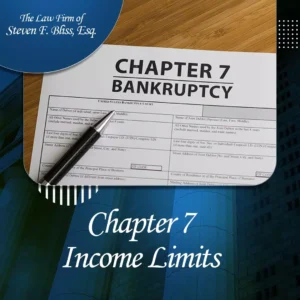If you would like to file a Chapter 7 bankruptcy, you must pass the California means test.
What is the income limit for filing Chapter 7?
Listen to this Article on:
Limitations and Income Limits to Filing For Chapter 7 Bankruptcy.
California Bankruptcy Means Test
If you would like to file a Chapter 7 bankruptcy, you must pass the California means test. The test only applies to higher-income filers. If your income is below the California median for your household size, you are exempt from the examination and may file a Chapter 7. If you want to file for bankruptcy relief, one of the first things that you must determine is whether you meet the income limit for Chapter 7 bankruptcy.

Suppose your income is higher than the California median. In that case, you will need to complete the means test calculation to determine if you can pay back a portion of your unsecured debts through a Chapter 13 bankruptcy.
Means Test Exemptions
If your debts are not primarily consumer debts, you are exempt from the means test. You are also exempt from the means test if you are a disabled veteran and incurred your debt primarily during active duty or performing a homeland defense activity.
California Median Income
Suppose your current monthly household income is less than the California median income for a household of your size. In that case, there is a presumption that you pass the means test and are eligible to file a Chapter 7 bankruptcy.
Please Help Us Spread The Word By Giving Us a 5 Star Rating on This Article
Free Initial Consultation with
Steven F. Bliss Esq.

★ ★ ★ ★ ★

Your average household income is determined by averaging your monthly income over the last six calendar months. If you are over the median income limit and your income has declined during the previous six months, then waiting one or more months might bring your income under the median level for California. Once you determine your average monthly income, you multiply that by 12 to determine your annual income for California median income test.
1 Member Household – $47,798.00
2 Member Household – $62,009.00
3 Member Household – $66,618.00
4 Member Household – $75,111.00
5 Member Household – $83,211.00
6 Member Household – $91,311.00
7 Member Household – $99,411.00
8 Member Household – $107,511.00
9 Member Household – $115,611.00
10 Member Household – $123,711.00
Examples of income used for the Chapter 7 Means Test include:
• Wages and salaries, including overtime, bonuses, and commissions
• Net income from self-employment or operation of a business
• Net income from rental property
• Unemployment income
• Workers’ compensation income
• Interest, royalties, and dividends
• Annuities, retirement income, and pensions
• Private disability insurance income
• Child support and spousal support
Regular income contributed by another person for household expenses, such as a non-filing spouse’s income and money from a roommate, domestic partner, parent, or friend.
Completing the Means Test
Section One – Median Income
It would be best if you had to understand two terms when completing the first part of the Chapter 7 Means Test — current monthly income (CMI) and annual median income. The median yearly income is based on your CMI. To calculate CMI, all income received during the six months before filing Chapter 7 and divided by six. Therefore, if your income for six months is $30,000, your current monthly income equals $5,000.00 ($30,000 divided by 6).
Means Test
If your income is over the California median income for a household your size, you must complete the means test by calculating your income and expense information.
It would be best to collect some of the information needed to complete the calculation, such as your current monthly income, from your records.
Income includes almost all of the sources of income you may have, including, but not limited to, business income, rental income, interest and dividends, pensions and retirements plans, amounts paid by others for your household expenses, and unemployment income.
Much of the information related to your expenses is based on national, California, and local averages and standards and comes from the Census Bureau and the Internal Revenue Service. You can include some actual expenses, such as obligations you are legally required to pay and expenses necessary for health and welfare.
After you have collected all the required information, you subtract all of your allowed expenses for California from your income to determine the amount of income under the bankruptcy law that you have available to pay your unsecured creditors in a Chapter 13 plan.
If your total monthly income over the next 60 months is less than $7,475, you pass the means test, and you may file a Chapter 7 bankruptcy. If it is over $12,475, you fail the means test and don’t have the option to file Chapter 7. If your disposable income under the means test is between $7,475 and $12,475, then you must do further calculations to determine if you have the option of filing a Chapter 7 case.
Remember that just because you can file a Chapter 7 does not mean that you should. Generally, a Chapter 7 bankruptcy is a better option if you are not attempting to keep secured property like a home with a mortgage. Still, you should consult with an attorney to determine your options and the best course to take.
California Chapter 7 Bankruptcy Income Limits
# of People Annual Income:
1 $62,938
2 $83,435
3 $92,735
4 $106,530
5 $115,530
6 $124,530
7 $133,530
8 $142,530
9 $151,530
